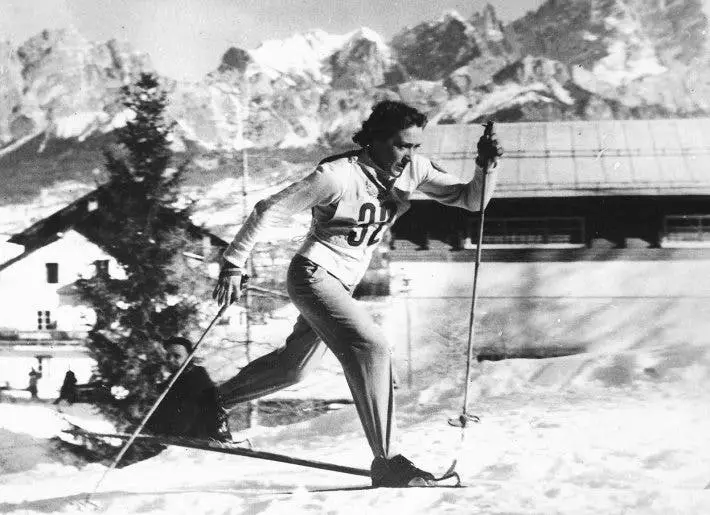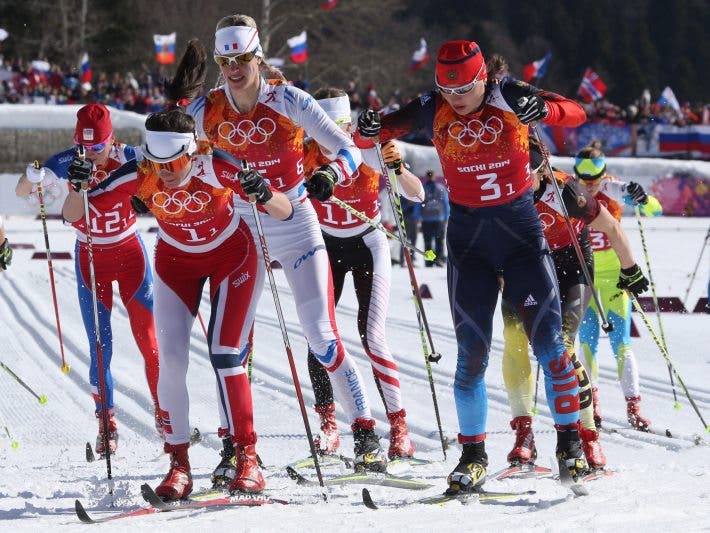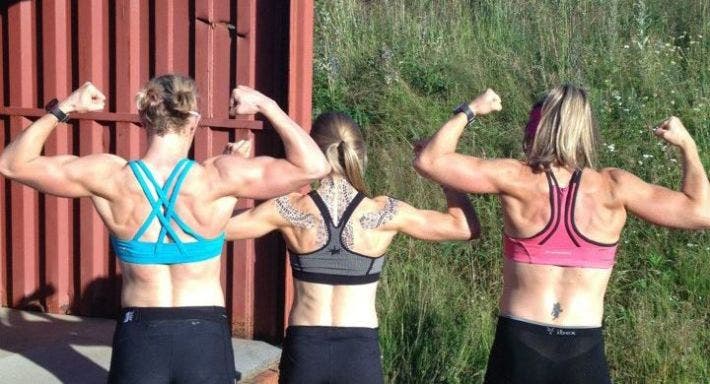Cross-country skiing has been an Olympic sport since the first Winter Olympic Games that were held in Chamonix France, in 1924. The incredible evolutions that the training used in this sport have undergone, as well as the material with which it is practiced and the preparation of the competition tracks have given him a very great impulse towards the professionalization of the same and an increase in the spectacularity. The speed of cross-country skiing races has increased more than any other Olympic endurance sport.

On the other hand, the introduction of different types of competition; pursuit, mass starting and the introduction of sprinting have brought new possibilities of specialization for athletes in this sport.
The fact that ten of the twelve current Olympic cross-country ski competitions involve mass starts, in which tactics play an important role and the result is often decided in the final sprint, helps us to reassess the factors of success for high performance in this modality.
The aerobic capacity (VO2max) of many of today’s world-class skiers is similar to that of their predecessors. At the same time, new modes of competition provide more opportunities to benefit from anaerobic capacity, upper body strength, great technical development at high speed and a new factor, “tactics”.
The wide range of speeds and unevenness involved in cross-country skiing requires that skiers are continually changing technique and being able to adapt to different sub-techniques during the course of a race. This complexity places particular emphasis on energy and technical efficiency.
The relative volumes of resistance training performed at different levels of intensity have remained essentially constant over the past four decades. However, in preparation for the Sochi 2014 Olympics, cross-country skiers have done more resistance training in rollerski with specific competitions, they have placed more emphasis on upper body strength and high speed technique with compared to previous seasons.
In the mid-1980s, a number of major changes have been introduced to cross-country skiing. The introduction of the skating technique, followed by the introduction of new racing modalities, such as the chase format, mass starts and sprinting. In connection with the Sochi Olympics, the women’s and men’s cross-country skiers faced the following events:
- 10 and 15km individual time trial, respectively in classic technique.
- 15 and 30km pursuit, respectively, during which skiers used the classic technique for the first half of the distance and the skater technique for the remaining distance of the event.
- 30 and 50km mass start, respectively, in skating technique (Free Style).
- 1.3 and 1.8km sprint in classical technique, respectively, including an individual classification test against the clock in which the best thirty times are selected to perform the batteries of six athletes per session.
- Relay races composed of four athletes 5 and 10 km each relay, respectively, the first two relays in classical technique and the last two relievers in skating technique.
- Speed relay races called Team Sprint in which each athlete performed three laps (alternating with their partner) 1.3 women and 1.8 km men.
Eight of the 12 cross-country skiing events that were held in Sochi either did not exist or have been significantly modified in format, compared to the Olympic games in Lillehammer in 1994.
| Sprint skiers | Distance skiers |
|---|---|
| In total, from 750 to 850 hours of training per year, of which 75-80% was aerobic resistance training. | In total, 800 to 900 hours of training per year, of which 85% was aerobic endurance training. |
| About 450-500hs or 300 low intensity sessions (at 60-80% of maximum heart rate). | 500 / 600hs or 300/350 low intensity sessions (60-80% of maximum heart rate). |
| About 25-30 sessions at moderate intensity (80-90% of maximum heart rate). | About 30-40 sessions of moderate intensity (80-90% of maximum heart rate). |
| 50-60 sessions per year at high intensity (above 90% of maximum heart rate). | 60-70 sessions per year at high intensity (above 90% of maximum heart rate). |
| 15-25 training sessions in lactic anaerobic work. | 5-15 training sessions in lactic anaerobic work. |
| Power and speed development throughout the season, including 1 or 2 sessions of pure speed, 2 or 3 sets of reaction speed training, and 2 strength training sessions per week. | Power and speed development throughout the season, including 1 session of pure speed, 2 or 3 sets of reaction speed training, and 1 to 2 sessions of strength training per week. |
| 400-500hs of training in a specific way (skiing, roller skiing, running with poles). | 400-500hs of training in a specific way (skiing, roller skiing, running with poles). |
| The emphasis is greater on training on flat terrain and not excessive unevenness. | Equal emphasis of training on steep, flat and varied terrain. |
These extensive changes motivate a reassessment of the success factors for high-performance cross-country skiing for Olympic skiers and the associated consequences for training and specialization in speed or distance events.
Current cross-country skiing demands

Although cross-country ski races can last from 12 minutes (4 races of 3 min in the Team Sprint mode) and more than 2 hours (in a race of 50km), 10 of the 12 Olympic competitions involve the type of start in mass, where the tactic is more important than before and the result is often decided in the final sprint.
The terrain where it is competed varies, but it has to comply (FIS regulations) with the premise of including approximately one third ascent, one third flat and one third descent. This forces skiers to constantly modify their technique. However, more than 50% of the time of a race is with uphill sections, which is where the variation in individual performance is greatest.
The proportion of energy contributed by the total aerobic system expended during these competitions (approx. 70-75% in sprint and 85-95% in distance tests) this of course is comparable to the corresponding values in other sports with times of similar career. However, cross-country skiers often adopt a more intense uphill running strategy, resulting in considerably higher work rates than required. This strategy of increasing the uphill pace is achieved by using the downhill areas for recovery during the course of the event.
Physiological characteristics of today’s elite skiers

World-class cross-country skiers have demonstrated some of the highest values in maximal oxygen uptake (VO2 max) on record of 80 to 90 and 70 to 80 ml / kg / min-1 for men and women, respectively. Absolute values greater than 7L / min have been recorded among various male medal winners (unpublished data). Therefore, oxygen transport is being studied very much, at temperatures as low as -20 ° C, during competitions.
Current world-class cross-country skiers from countries such as Norway and Sweden demonstrate aerobic capacity similar to that of previous Olympic champions. However, the new needs, due to the modifications that have been in the tests, have meant that everyone has increased and modified the training on anaerobic capacity, strength in the upper body and technique at high speeds, as well as they have also incorporated tactical training in order to aspire to win medals.
For example, in relation to sprint mode, speed over a short distance and maximum strength are closely correlated with performance. The absolute values of VO2max. exhibited by top-level sprint and distance skiers are similar, but sprinters have slightly lower values relative to body mass and also have higher anaerobic capacity.
In the case of both sprint distance, the ability to efficiently transform metabolic energy into speed is a determining factor of performance. This observation likely reflects technical complexity, with numerous levels of force that have to be generated by the arms and legs relative to other endurance sports.
Biomechanics of cross-country skiing
Cross-country skiing has become an object of interest and desire for study and analysis, with increasing attention being focused on performance biomechanics and energy efficiency at low temperatures.
Cross-country skiers must master a wide range of speeds (5-70 km / h) and terrains (with slopes of up to 20%). To achieve this, they must continually change and adapt their technique to achieve the expected results.
During a speed test (1.8km), skiers change the used sub-technique approximately 30 times while in a long distance race these transitions occur hundreds of times. This is unique compared to other Olympic sports. In both skater and classic, higher speeds result in greater demands on force production to increase the duration of the force cycle during an event.
An important strategy to increase the duration of the strength cycle is to improve the double cane technique (see published articles). The pre-activation and shortening of the muscles activates the production of force to achieve a higher speed in the double-pole movement.
One of the most developed techniques and in which the force factor predominates is the double pole in classical technique and the double pole with impulse in skating technique. With these techniques, the most explosive skiers can produce peak forces of up to 430N in a period of 0.05 seconds, as well as forces in excess of 1600N during the skater leg thrust.
On fairly steep terrain, faster skiers increase the frequency of movement to try to maintain speed, innovative techniques such as “running uphill” in classic technique or jumping steps in skating technique are used to achieve faster acceleration uphill. In addition, more attention has recently been focused on the descent of a race, especially the curve descent, where faster skiers use the acceleration of the turning step to be able to exit the curve at a higher speed.
Training for Olympic skiers

Endurance training has always been the main component in cross-country skier training. For research purposes, 3 intensity levels (low or slow pace, medium or threshold pace, and high pace) have been defined, but for practical reasons many skiers today use 4 or 5 intensity levels in relation to their resistance training. .
Based on the athletes’ session approach, cross-country skier endurance training consists of a “composite” model with a large amount of low intensity training and low to moderate amounts of high intensity work. The number of hours of resistance training at these different levels has apparently not changed over the past three decades, skiing, roller skiing, and cross-country running remain the predominant exercise activities. However, during this same period, three different developments in training have been observed:
- Increase in the hours of work carried out in rollerskis, often on special tracks for practice that imply a more specific and safe terrain for this modality.
- More emphasis has been placed on strength and endurance training especially of the upper body.
- Skiers have consistently incorporated strength, power, and speed training work, especially skiers who specialize in sprint races.
Tactical aspects of cross-country skiing
In individual races, skiers increase their intensity a lot on the climbs, where individual aerobic capacity predominates and the metabolic cost is higher. In long-distance runs on relatively flat terrain, the heart rate and speed are usually more constant. In contrast to this, the technique as well as the intensity during a cross-country skiing test must take into account more variables, since the track profiles vary, as well as the snow conditions at different times during a season or even a single race. .
On the other hand, the introduction of mass start racing has accentuated the importance of the wheel drive concept, also known as drafting. With this new type of outing, potential team tactics can sometimes provide an advantage over such races. However, team tactics in cross-country skiing are different from those employed in cycling competitions, for example, due to the slow speeds involved, the narrower slopes and the fact that only four skiers from each country are allowed. compete by test (in olympic games and world championship). Also, the pace of work on uphill terrain is often too demanding for weaker skiers, so the typical sprints or attacks seen in cycling are very rare in cross-country skiing.
Future
The International Ski Federation has decided to keep the current competition program for the next Olympic Games, so the demands of new needs in this context are probably not going to change compared to previous years. Although the physiology and biomechanics of cross-country skiers have been analyzed in detail in laboratories in recent decades, relatively little is still known about actual, outdoor competitions at different temperatures and with a variety of snow conditions and ski profiles. tracks.
Recent advances in sensor technology allow to know the position of the skier’s body, speed, kinematics and kinetics that are recorded in real time on the ski slope, this gives us more detailed information on the factors that lead to improvement. in different ways that was impossible before. On the other hand, the increase in the complexity of both aspects the physiological (the same aerobic demands, but greater anaerobic demands) and the technique (many sub-techniques to master) for modern skiers forces them to increase the individual demand and increasingly these future champions will have to adapt faster and better to the new theories of modern training.
Better input from actual competition conditions will enhance our ability to provide specific best practice guidelines for training future Olympic champions.
References
- Sandbakk O, Ettema G, Leirdal S, Jakobsen V, Holmberg HC. Analysis of a ski sprint race and the associated laboratory determinants of world-class performance. Eur J Appl Physiol. 2011; 111 (6): 947-957. PubMed doi: 10.1007 / s00421-010-1719-9.
- Andersson E, Supej M, Sandbakk O, Sperlich B, Stoggl T, Holmberg HC. Cross-country skiing sprint analysis using a global differential satellite navigation system. Eur J Appl Physiol. 2010; 110 (3): 585-595. PubMed doi: 10.1007 / s00421-010-1535-2.
- Norman RW, Komi PV. Energetic world-class cross-country skiing mechanics. Int J Sport Biomech. 1987; 3: 353-369.
- Holmberg HC, Rosdahl H, Svedenhag J. Lung function, arterial saturation, and oxygen consumption in elite cross-country skiers: the influence of exercise modality. Scand J Med Sci Sports. 2007; 17 (4): 437-444. PubMed
- Ingjer F. Maximal oxygen consumption as a predictor of the performance capacity of elite cross-country skiers. Scand J Med Sci Sports. 1991; 1 (1): 25-30. doi: 10.1111 / j.1600-0838.1991.tb00267.x
- Rusko H, ed. Cross-country skiing physiology. Oxford: Blackwell; 2002.
- Saltin B, Astrand PO. Maximum oxygen consumption in athletes. J Appl Physiol. 1967; 23 (3): 353-358. PubMed
- Holmberg HC. The competitive cross country skier – an impressive human engine. In: Muller E, Lindinger SJ, Stöggl T, eds. Science and Ski IV. Maidenhead, UK: Meyer & Meyer Sport; 2009: 101-109.
- Ekblom B, Hermansen L. Cardiac output in athletes. J Appl Physiol. 1968; 25 (5): 619-625. PubMed
- Stöggl T, Lindinger S, Muller E. Analysis of a simulated sprint competition in classic cross-country skiing. Scand J Med Sci Sports. 2007; 17 (4): 362-372. PubMed
- Stoggl T, Muller E, Ainegren M, Holmberg HC. General strength and kinetics: critical to faster sprinting in cross-country skiing? Scand J Med Sci Sports. 2011; 21 (6): 791-803. PubMed doi: 10.1111 / j.1600-0838.2009.01078.x
- Sandbakk O, Holmberg HC, Leirdal S, Ettema G. Physiology of the world speed class skiers. Scand J Med Sci Sports. 2011; 21 (6): e9-e16. PubMed doi: 10.1111 / j.1600-0838.2010.01117.x
- Sandbakk O, Holmberg HC, Leirdal S, Ettema G. Metabolic rate and gross efficiency at high work rates in world class and national level sprint skiers. Eur J Appl Physiol. 2010; 109 (3): 473-481. PubMed doi: 10.1007 / s00421-010-1372-3
- Mahood NV, Kenefick RW, Kertzer R, Quinn TJ. Physiological determinants of performance in cross-country skiing races. Med Sci Sports Exerc. 2001; 33 (8): 1379-1384. PubMed doi: 10.1097 / 00005768-200108000-00020
- Millet GP, Vleck VE. Physiological and biomechanical adaptations to the cycle to execute the transition in the Olympic triathlon: review and practical recommendations for training. OIJ Sports Med. 2000; 34 (5): 384-390. PubMed doi: 10.1136 / bjsm.34.5.384
- Holmberg HC, Lindinger S, Stoggl T, Eitzlmair E, Muller E. Biomechanical analysis of double polarization in elite cross-country skiers. Med Sci Sports Exerc. 2005, 37 (5): 807-818. PubMed DOI: 10.1249 / 01. MSS.0000162615.47763.C8
- Lindinger SJ, Holmberg HC, Muller E, Rapp W. Changes in upper body muscle activity with increasing speeds of Polin doubled in elite cross-country skiing. Eur J Appl Physiol. 2009; 106 (3): 353-363. PubMed DOI: 10.1007 / s00421-009-1018-5
- Stoggl T, Muller E, Lindinger S. Biomechanical comparison of dual push technique and conventional skate skiing technique in sprint cross-country skiing. J Sports Sci. 2008; 26 (11): 1225-1233. PubMed DOI: 10.1080 / 02640410802027386
- Sandbakk Bucher S, Supej M, Sandbakk O, Holmberg HC. Downhill Turn Dignity and Associates Physical Characteristics of Cross Country Skiers [Advance Online Posting, March 20, 2013]. Scand J Med Sci Sports. 2013 PubMed doi: 10.1111 / sms.12063
- Sandbakk O, Ettema G, Holmberg HC. Influence of Incline and Lost Work Speed, Gross Efficiency and Roller Skating Kinematics. Eur J Appl Physiol. 2012; 112 (8): 2829-2838. PubMed DOI: 10.1007 / s00421-011-2261-0
- Abbiss CR, Laursen PB. Describe and understand stimulation strategies During athletic competition. Med Sports. 2008; 38 (3): 239-252. PubMed DOI: 10.2165 / 00007256-200838030-00004
- Bilodeau B, Roy B, Boulay MR. Wording effect on the heart was lost in cross-country skiing. Med Sci Sports Exerc. 1994; 26 (5): 637-641. PubMed DOI: 10.1249 / 00005768-199405000-00018
- Gaskill SE, Serfass RC, Bacharach DW, Kelly JM. Responses to cross-country skier training. Med Sci Sports Exerc. 1999; 31 (8): 1211-1217. PubMed DOI: 10.1097 / 00005768-199908000-00020
- Seiler KS, Kjerland GB. Quantification of Training Intensity Distribution in Elite Endurance Athletes: Is There Evidence for “Optimal” Distribution? Scand J Med Sci Sports. 2006; 16 (1): 49-56. PubMed DOI: 10.1111 / j.1600-0838.2004.00418.x